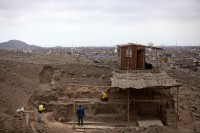 The ancient pre-Inca archaeological site of Garagay in the San Martín de Porres neighborhood of northern Lima was first unearthed in 1959. The stone and mud brick temple’s striking high relief polychrome friezes of mythical beasts appeared stylistically linked to the Chavin culture, and archaeologists believed the Chavin art inspired the Garagay reliefs. The U-shape of the temple complex with a central pyramid 100 feet high and rectangular buildings on the sides was also reminiscent of Chavin structures.
The ancient pre-Inca archaeological site of Garagay in the San Martín de Porres neighborhood of northern Lima was first unearthed in 1959. The stone and mud brick temple’s striking high relief polychrome friezes of mythical beasts appeared stylistically linked to the Chavin culture, and archaeologists believed the Chavin art inspired the Garagay reliefs. The U-shape of the temple complex with a central pyramid 100 feet high and rectangular buildings on the sides was also reminiscent of Chavin structures.
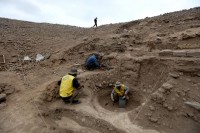 The finds were not documented or photographed at the time, and although they were reburied for their own protection, looters and illegal construction got to them anyway, destroying the spectacular reliefs. Fifteen years would pass before funding was secured to excavate Garagay again. The 1974 excavation discovered more polychrome reliefs, thousands of ceramic artifacts, and rare surviving textiles. It also determined the age of the site. Radiocarbon dating found that the Garagay complex was built around 1800 B.C., was added to and rebuilt multiple times and remained in use until around 800 B.C. That means the early temples and their reliefs predate the Chavin culture, so if there was any influence, it was the other way around.
The finds were not documented or photographed at the time, and although they were reburied for their own protection, looters and illegal construction got to them anyway, destroying the spectacular reliefs. Fifteen years would pass before funding was secured to excavate Garagay again. The 1974 excavation discovered more polychrome reliefs, thousands of ceramic artifacts, and rare surviving textiles. It also determined the age of the site. Radiocarbon dating found that the Garagay complex was built around 1800 B.C., was added to and rebuilt multiple times and remained in use until around 800 B.C. That means the early temples and their reliefs predate the Chavin culture, so if there was any influence, it was the other way around.
This time the unearthed temples were not reburied. A fence was erected around the site to keep vandals and looters out, but it didn’t work. Treasure hunters trashed the site looking for gold and easily saleable antiquities. Illegal home construction — some as high as five stories — mushroomed up between the fence and the temple in the mid-1980s. A factory was built in the main square of the complex and workers used the soil and clay from one of the arms of the U to make the bricks for the factory walls.
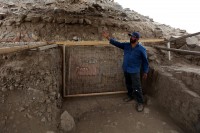 As if that weren’t bad enough, a high voltage tower erected at the high point of the pyramid in 1963 (the year before laws protecting archaeological sites to prevent this kind of abuse were passed) became a target of the Shining Path terrorists. They tried to blow it up with dynamite three times in the 1980s to cut off the electricity to the city. Because mud bricks are tough as hell and the ancient Peruvians were worth 20 million of those Shining Path brutes, the Garagay complex withstood the explosives, but it took heavy damage.
As if that weren’t bad enough, a high voltage tower erected at the high point of the pyramid in 1963 (the year before laws protecting archaeological sites to prevent this kind of abuse were passed) became a target of the Shining Path terrorists. They tried to blow it up with dynamite three times in the 1980s to cut off the electricity to the city. Because mud bricks are tough as hell and the ancient Peruvians were worth 20 million of those Shining Path brutes, the Garagay complex withstood the explosives, but it took heavy damage.
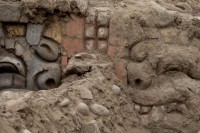 The site was neglected for four decades, but excavations have finally begun again. The site is currently being excavated by Lima municipal archaeologists who have added information panels to emphasize the complex’s immense archaeological significance as the largest temple complex of its kind in the Rimac Valley and the best example of architecture from Lima’s Formative Period. Because only an estimated 3% of the compound has been unearthed, archaeologists are hopeful that despite all the losses, the site has many wonders left to discover which would make it a draw for tourists (and their cash) and increase the neighborhood’s understanding of and investment in the great treasure in their midst.
The site was neglected for four decades, but excavations have finally begun again. The site is currently being excavated by Lima municipal archaeologists who have added information panels to emphasize the complex’s immense archaeological significance as the largest temple complex of its kind in the Rimac Valley and the best example of architecture from Lima’s Formative Period. Because only an estimated 3% of the compound has been unearthed, archaeologists are hopeful that despite all the losses, the site has many wonders left to discover which would make it a draw for tourists (and their cash) and increase the neighborhood’s understanding of and investment in the great treasure in their midst.
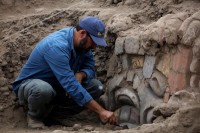 This January, the team discovered a zoomorphic jaguar-like frieze in the atrium of the main pyramid. In May lead archaeologist Hector Walde announced the team unearthed new high relief polychrome friezes carved on a pilaster in the temple complex’s ceremonial entrance. They are in an excellent state of conservation, with the colors of one of them still brilliant. The figures are large anthropomorphic faces with feline characteristics. Archaeologists have also discovered access stairways connected to the main courtyard of the complex have been discovered as well.
This January, the team discovered a zoomorphic jaguar-like frieze in the atrium of the main pyramid. In May lead archaeologist Hector Walde announced the team unearthed new high relief polychrome friezes carved on a pilaster in the temple complex’s ceremonial entrance. They are in an excellent state of conservation, with the colors of one of them still brilliant. The figures are large anthropomorphic faces with feline characteristics. Archaeologists have also discovered access stairways connected to the main courtyard of the complex have been discovered as well.
The excavation is scheduled to continue for five years.
Amiens Cathedral is one of the finest examples of late Gothic art in Europe.